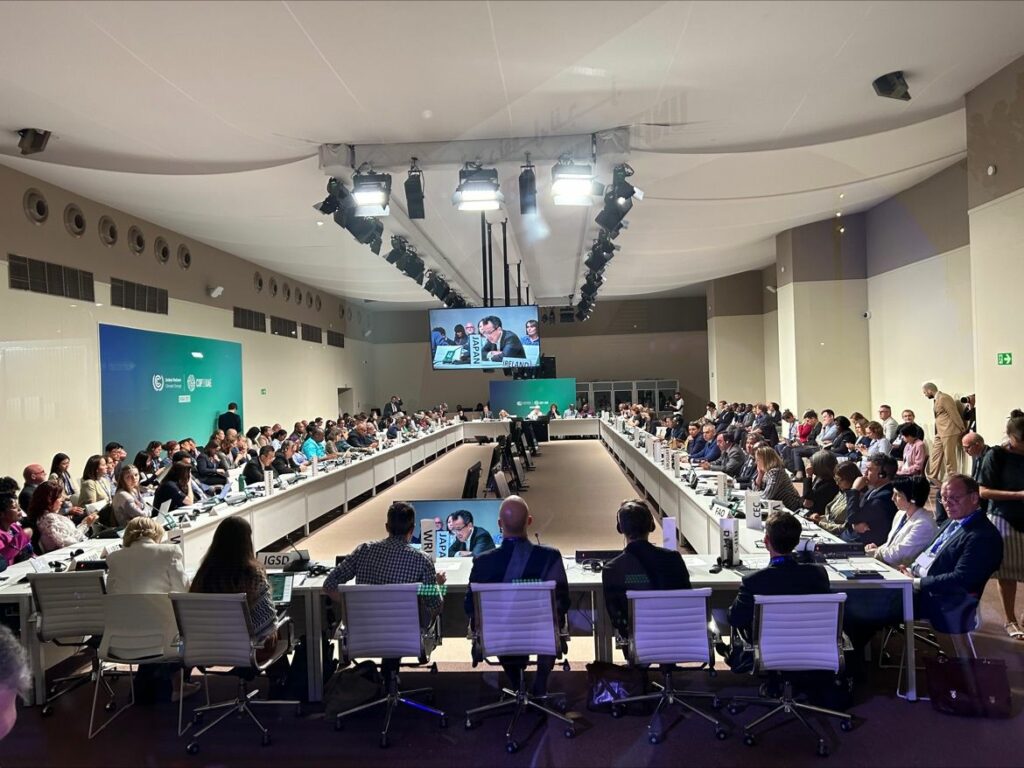The COP series has reached a terminal phase of effectiveness. COP 28 is being prepared in a climate of boycott and mistrust. The process has been able to deliver results. It is now outdated. Nor does any government arrive at the COP with a serious plan to meet the challenges. Procrastination has gone on long enough. It’s now up to local authorities, civil society and businesses to take up the baton and lead the way. Let’s take a look at the role now expected of boards of directors on climate issues.
Why COP Series Has Reached a Terminal Phase of Effectiveness
I’ve personally been lucky enough to take part in several COPs. I was disappointed at COP 15. I experienced the ecstasy of historic progress at COP 21. I experienced COP 26 with the feeling that, in the end, everyone was just pretending to do something. We’ve been invited several times to take part in COP 28. We declined several times, then eventually concluded we would attend because we want to encourage climate action with many of our stakeholders attending COP 28 as well. This remain obviously concerned observing how COP 28 is preparing for the formal climate negotiations. I am therefore opinionated on purpose why I consider COP series to have become useless overall.
The COP (Conference of the Parties) climate process, established under the United Nations Framework Convention on Climate Change (UNFCCC), faces several challenges that impede effective global climate action.
- One notable failure is the persistent struggle to achieve binding and ambitious emission reduction commitments from major emitters. Despite scientific consensus on the urgent need to limit global warming, negotiations often stall due to conflicting national interests, economic concerns, and geopolitical tensions.
- Another critical issue is the inadequacy of financial commitments to support climate mitigation and adaptation efforts, particularly for developing nations. The promised mobilization of $100 billion annually by developed countries to assist developing nations in coping with climate change has been elusive, hindering the implementation of crucial projects and hampering the global transition to a low-carbon economy.
- Moreover, the COP process struggles with the enforcement and monitoring of commitments made by participating countries. The lack of robust mechanisms to ensure transparency and accountability hampers the credibility of the entire climate regime. Additionally, the pace of negotiations and decision-making often lags behind the rapid escalation of climate impacts, rendering the process insufficiently responsive to the evolving climate crisis.
Addressing these failures requires collective political will, enhanced cooperation, and a commitment to prioritize the common good over national interests. The COP climate process must evolve to effectively address the escalating climate emergency and ensure a sustainable future for the planet. Now, COP 28 will be held at the end of the month. 4 priorities have been outlined. They are all critical. But no critical breakthrough can be expected at COP 28. No leadership will be there.
A Tripartite Approach Involving Territories, Civil Society, and Corporations is Essential for a Holistic and Effective Response to the Climate Crisis
Not a single government offers a climate program that measures up either to the stakes or to its own commitments made to the COPs. This layer is discredited. Critical action therefore lies at a more granular level. Territories, civil society, and corporations therefore all play pivotal roles in advancing climate action. Local and regional governments, encompassing territories, have the power to implement and enforce climate policies tailored to their unique contexts.
- Territories. By investing in renewable energy, sustainable infrastructure, and resilient urban planning, territories can significantly contribute to emissions reduction and climate resilience.
- Civil society acts as a catalyst for change by raising awareness, advocating for policy reforms, and holding governments and corporations accountable. Grassroots movements, NGOs, and community organizations play vital roles in promoting sustainable practices, influencing public opinion, and fostering a sense of environmental responsibility.
- Corporations wield substantial influence in shaping the global economy and can drive climate action through sustainable business practices. Adopting environmentally friendly technologies, committing to carbon neutrality, and incorporating circular economy principles into operations are ways corporations can contribute. Collaboration between corporations, governments, and civil society can lead to innovative solutions and shared responsibility.
Overall, a tripartite approach involving territories, civil society, and corporations is essential for a holistic and effective response to the climate crisis, fostering a sustainable future that balances economic prosperity with environmental stewardship.
Role of Boards of Directors Taking Leadership?
Boards of directors play a critical role in overseeing a company’s approach to biodiversity and climate issues. Given the growing importance of these issues in the business world, effective oversight is vital for a company’s sustainability and long-term success. Here are several steps and practices that boards can implement to properly oversee biodiversity and climate issues:
- Education and Training: Ensure that board members are adequately educated and trained on biodiversity and climate-related risks, opportunities, and best practices. This may involve seminars, workshops, or bringing in experts to provide insights and knowledge.
- Integration into Strategy: Integrate biodiversity and climate considerations into the company’s overall strategy, business plans, and risk management processes. Align these considerations with the company’s mission, vision, and values.
- Appoint Expertise: Consider appointing a board member or establishing a committee with expertise in biodiversity, climate science, or sustainability. This individual or committee can provide specialized guidance and oversight on these matters.
- Set Clear Goals and Targets: Establish measurable and time-bound goals related to biodiversity and climate issues. These goals should align with global frameworks like the Sustainable Development Goals (SDGs) and science-based targets to reduce greenhouse gas emissions.
- Regular Reporting and Monitoring: Require management to provide regular, detailed reports on the company’s progress toward achieving biodiversity and climate-related goals. Monitor performance against set targets and hold management accountable for meeting these goals.
- Engagement with Stakeholders: Encourage meaningful engagement with stakeholders, including shareholders, customers, suppliers, and communities. Consider their perspectives and input when making decisions related to biodiversity and climate.
- Consider Supply Chains and Operations: Assess the impacts of the company’s supply chain and operations on biodiversity and climate. Encourage sustainable sourcing, production, and distribution practices to minimize negative impacts.
- Risk Assessment and Management: Conduct comprehensive risk assessments to identify and evaluate biodiversity and climate-related risks. Develop appropriate risk management strategies to mitigate these risks and seize opportunities for sustainable business practices.
- Incentivize Sustainability: Link executive and employee compensation to the company’s performance on sustainability metrics, including those related to biodiversity and climate. This incentivizes individuals within the organization to prioritize and contribute to sustainability efforts.
- Advocacy and Industry Collaboration: Encourage the company to actively advocate for strong policies and regulations that promote biodiversity conservation and climate action. Collaborate with industry associations to drive collective efforts towards sustainability.
- Transparency and Disclosure: Advocate for transparency and clear disclosure of the company’s environmental impacts, initiatives, and progress related to biodiversity and climate. Ensure that stakeholders have access to accurate and timely information.
- Regular Board Evaluations: Conduct periodic evaluations of the board’s effectiveness in overseeing biodiversity and climate issues. Use the insights gained to continuously improve governance processes.
By implementing these steps and practices, boards of directors can effectively take leadership to oversee biodiversity and climate issues, ensuring that their organizations are proactive and responsible in addressing these critical challenges.
Conclusions
Global leadership steering climate action is not facing a conducive geopolitical environment. International crises such as the war in Ukraine, or the recent rapprochement between Russia and North Korea remain major sources of concern. The rivalries posed by the US-China duel are generating a myriad of strategic and operational consequences for American, Chinese and European companies alike. In response to this growing inpredictability, the need to strengthen Boards’ skills in environmental and social issues is more topical than ever. This is as much a strategic imperative as it is a regulatory compliance issue.
Author of several books and resources on business, sustainability and responsibility. Working with top decision makers pursuing transformational changes for their organizations, leaders and industries. Working with executives improving resilience and competitiveness of their company and products given their climate and human right business agendas. Connect with Farid Baddache on Twitter at @Fbaddache.






